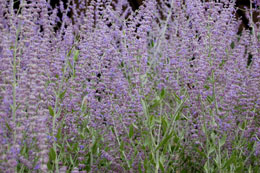Russian sage is a common garden plant appreciated for its lovely flowers and its resistance to dry conditions. Easy to grow and requiring minimal care, you can grow healthy sage in your garden as well as in containers.

Maintaining a summer or fall garden is never complete unless you include Russian sage. It is a popularly-opted flowering plant for xeriscaping because of its tolerance to prolonged dry spells. Even if you do not have time to water or nurture this plant, it will not fail in beautifying your flower garden with magnificent, pale violet colored blooms. Other desirable features of this hardy perennial are long flowering periods and flower production in cold environmental conditions.
What is it?
The Russian sage is indigenous to central parts of Asia. It belongs to the mint family
Labiatae and is scientifically known as
Perovskia atriplicifolia. Despite its common name, the Russian sage is not a relative of the common sage genus
Salvia. The name resemblance may be because of its scented foliage, which is applicable for all herbs of the mint family. The growth habit of this plant is perennial herbaceous or subshrub, in which the height at maturity is 4 feet, while maximum spread measures about 3 feet.
Identification of this sage plant can be done from its stems, leaves and flowers. The stem is hairy, whitish colored, square-shaped, erect, and woody at the base and soft in the upper portion. The foliage of this purple flowering plant is about 5 cm long and 3 cm wide, silvery in color and deeply notched in shape. As summer arrives, tubular, lavender colored flowers are borne in clusters, and the inflorescence type is panicle. The flowering period starts in midsummer and lasts till fall, where there are hardly any colored blooms in the garden.
Caring for Russian Sage
Although Russian sage can adapt to a wide range of soil types, it grows best in USDA zones 4-9. This herbaceous plant is best suited for plantation in flower beds or as borders for seasonal flowers. The preferred growing conditions for this sage are maximum sunlight exposure, medium fertile soil and moderate water. When planted as a shrub for shaded areas, the branches tend to flop down on one side. Hence, staking and additional plant care is required to give it a proper shape.
Select a sunlit area for growing this sage in your flower garden. If you don't have a specific spot, go for container gardening. Preparing the garden soil is not necessary, as this plant can grow well even in poor soil. But, to ensure quick establishment and production of roots, loosen garden soil with a trowel. Select suitable, upright varieties (Filigran or Login) and choose propagation method according to your convenience. They are propagated from seeds or rooted stem cuttings.
If you are a newbie, opt for the plantlets for easy growing. Make a planting hole in the garden soil, remove the plant from the original container and place it in the hole. Refill the soil in the hole and press it down lightly. Water your newly planted sage only occasionally, as it cannot tolerate wet soil. Make sure that you do not over-water this perennial plant. Adding a fertilizer is not at all required, even after it attains maturity.
Pruning of this plant should be done in the spring, or after winter is over. You can select and remove weak branches with sharp scissors, making sure that the remaining plant parts are not injured. This trimming of the older twigs promotes new growth of branches, thus giving a dense, bushy shape. Many hobbyists prefer cutting the stems to about 6 inches above ground level for renewed growth of branches. Overall, pruning prepares the plant for production of healthy blooms in mid summer.
Thus, maintaining a sage plant requires minimal effort, irrespective of whether you want it to plant indoors or outdoors. With its richly fragrant leaves and tubular flowers, this plant attracts butterflies in the garden. During the blooming period, you can make cut flowers for beautifying your room interior, or you can dry them for decoration purposes.






 Maintaining a summer or fall garden is never complete unless you include Russian sage. It is a popularly-opted flowering plant for xeriscaping because of its tolerance to prolonged dry spells. Even if you do not have time to water or nurture this plant, it will not fail in beautifying your flower garden with magnificent, pale violet colored blooms. Other desirable features of this hardy perennial are long flowering periods and flower production in cold environmental conditions.
Maintaining a summer or fall garden is never complete unless you include Russian sage. It is a popularly-opted flowering plant for xeriscaping because of its tolerance to prolonged dry spells. Even if you do not have time to water or nurture this plant, it will not fail in beautifying your flower garden with magnificent, pale violet colored blooms. Other desirable features of this hardy perennial are long flowering periods and flower production in cold environmental conditions.